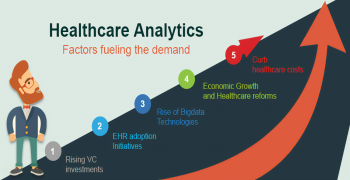How data analytics is lowering healthcare costs
By
Last Updated May 05, 2023
Across industries, big data analytics has changed how we manage, analyse, and leverage data. Healthcare is one of the most visible industries where data analytics is having a significant impact. When used correctly, data analytics in healthcare can lower treatment costs, provide a comprehensive understanding of patients and the conditions that affect or have the potential to affect them, and improve overall quality of life. Healthcare data analytics combines historical and real-time data to forecast trends, reveal actionable insights, achieve medical breakthroughs, and drive long-term growth.
According to an Allied Market Research report, the global healthcare analytics market is expected to reach $96.90 billion by 2030, up from $23.51 billion in 2020, at a CAGR of 12%. The need for laboratory automation and efficiency, as well as the rising prevalence of chronic diseases, have all contributed to a surge in the adoption of big data in the healthcare industry.
Aside from the aforementioned factors, healthcare organisations are increasingly turning to big data analytics to reduce overspending on poor inventory management, patient care, and staff deployment. This article will primarily focus on how data analytics is assisting medical institutions and professionals with patient care and cost reduction. But first, let's look at the different types of healthcare analytics and how they can affect change in the healthcare industry.
Table of content
Let us see How data analytics is lowering healthcare costs :
1. What types of data analytics are there in healthcare?
2. Top ways to reduce healthcare costs through data analytics
3. The Future of Healthcare Data Analytics
4. Syoft's Contribution to Data Analytics
What types of data analytics are there in healthcare?
Based on the goals and needs of healthcare professionals and institutions, four types of healthcare analytics can be used. Depending on the situation, each type is critical for making the most of healthcare data.
Descriptive analytics: Descriptive analytics provides a historical view of data, allowing healthcare providers and management to determine whether current practices are efficient and, if necessary, make recommendations. Modelling and forecasting are used in predictive analytics to determine what is likely to happen next. It assists healthcare providers in calculating risk scores for each patient and identifying which patients may require extra attention. Predictive analytics, on the other hand, does not indicate the prevention of adverse events such as hospitalisation.
Diagnostic analytics: Diagnostic analytics assists in determining why something occurred so that appropriate actions can be taken. It is useful in determining what events and factors led to a particular outcome. Diagnostic analytics, like descriptive analytics, entails an examination of historical data.
Prescriptive analytics: This type of analytics enables us to determine what actions are required to alter the prediction. It employs advanced algorithms to assist in determining the effects of specific actions and providing solutions by applying historical data to achieve a specific result. It is the most useful and powerful type of analytics, providing healthcare professionals with guidance recommendations.
Top ways to reduce healthcare costs through data analytics
When data analytics and visualisation are used correctly, they can increase patient access to services, resulting in lower costs, more revenue, and improved outcomes. Top ways to reduce healthcare costs through data analytics EHRs (Electronic Health Records): One of the most significant advantages of data analytics in healthcare is the digitization of medical records, which can result in significant savings. EHRs generate a large amount of data due to the wealth of clinical information they contain. EHR data includes administrative and diagnostic patient information that is updated in real-time for each encounter. EHR, in particular, offers details on procedures, demographics, length of stay, and fees. Additionally, EHRs improve care quality by triggering diagnostic warnings and reminders.
They also improve performance by streamlining routine tasks, reducing errors, and speeding up data access/entry, which significantly reduces healthcare costs.
Kaiser Permanente, a leading healthcare provider in the United States, has implemented an integrated system that shares data across all of its facilities and simplifies the use of EHRs This improved cardiovascular disease outcomes while saving the healthcare company $1 billion in-office visits and lab tests. As a result, a shared system of digitised patient records can save hospitals and healthcare facilities significant amounts of money.
Operating room demand is forecasted: Operating rooms are expensive to build, operate, and staff. As a result, optimising operating room use without jeopardising patients' health is in every hospital's best interest. To accomplish this goal, a number of healthcare providers and administrators are using data analytics to better understand the relationships between the numerous operating room variables that wreak havoc on effective scheduling. These variables include the availability of the surgeon, operating hours, and equipment. an integrated system that shares data across all of their facilities and simplifies the use of EHRs This improved cardiovascular disease outcomes while saving the healthcare company $1 billion in-office visits and lab tests.
As a result, a shared system of digitised patient records can save hospitals and healthcare facilities significant amounts of money.
Operating room demand is forecasted: Operating rooms are expensive to build, operate, and staff. As a result, optimising operating room use without jeopardising patients' health is in every hospital's best interest. To accomplish this goal, a number of healthcare providers and administrators are using data analytics to better understand the relationships between the numerous operating room variables that wreak havoc on effective scheduling. These variables include the availability of the surgeon, operating hours, and equipment.
Creating a surgical schedule is difficult with so many factors to consider. Fortunately, data analytics can aid in the automation of operating room management. Hospitals are now inundated with information about their employees, patients, and facilities. So, the best approach is to mine the right data, study operating room utilisation patterns, and use predictive modelling to match the most appropriate human and support resources with the right operating rooms.
For example, hospitals in Colorado, such as UCHealth, have switched to mobile apps that use cloud computing and predictive analytics to optimise operating room utilisation and eliminate schedule conflicts. Since the switch, UCHealth has seen a 4% increase in revenue from surgeries, or $15 million per year.
Optimizes staffing: In many healthcare facilities, on-the-fly scheduling is performed without regard for the future.
Because labour costs account for half of a hospital's budget, accurate staffing is critical. Data analytics is now assisting administration and managers in better coping with staffing challenges at least 30 days ahead of time. Data analytics for enterprise ventures employs intelligence to forecast and analyse historical staffing numbers, local weather trends, seasonal infections, holidays, and other variables that are unique to each organisation. This results in lower labour costs and more efficient, cost-effective shift management.
Prevents 30-day hospital readmissions: In the United States, unnecessary readmissions are common. They also impose an unnecessary financial burden on hospitals with limited resources. Reduced readmissions promise to save hospitals money. Data analytics tools can be used to identify patients who have specific symptoms or diseases that cause them. This allows healthcare providers to take extra precautions to keep the patient from returning within the 30-day window.
Analytics tools can also be used to create a heat map for each patient who has not been admitted to the hospital in the last 30 days. Healthcare professionals can use simple visual representations of the data to determine where the patient is most at risk during this 30-day period. This information assists them in planning future actions.
Data scientists at NYU Langone Medical Center, for example, have created a predictive analytics algorithm based on a wide range of clinical factors. It aids in the identification of patients who are likely to spend less than two nights in the hospital. The tool also assists physicians in determining when to place a patient on Prevents no-show appointments: When patients fail to arrive for scheduled appointments, the unexpected gaps in a practitioner's daily calendars can have financial consequences and disrupt the workflow. Using data analytics to identify patients who are likely to miss appointments without notice can reduce revenue loss significantly, allow medical professionals to offer open slots to other patients, and improve customer experience. According to a Duke University study, data analytics could capture 4,800 patient no-shows per year for greater accuracy.
Data analytics tools can also be used to predict when patients will arrive at facilities with no set schedules, such as urgent care centres or emergency departments. This, in turn, may help to improve staffing levels and reduce wait times. Reduces supply chain costs Hospitals, like all businesses, rely on the supply chain to run efficiently. If the chain breaks down, patient care and treatment suffer, and hospitals lose money.
Analytical tools keep efficiency and track supply chain metrics, saving up to $10 million per year. These tools also help to reduce documentation errors by automating requisitions, purchase orders, invoices, and other processes.
Prevents fraud and improves security: Data breaches and fraud claims are not uncommon in hospitals. In June 2020, the Department of Health and Human Services in the United States saw an increase in data breaches as cybercriminals took advantage of the Covid-19 pandemic's distractions. Such cybercrimes are expensive for hospitals, resulting in a revenue loss of nearly $3 million on average. In order to combat detect pattern changes in network traffic and other suspicious online behaviours, hospitals are using data analytics.
Organizations can also use data analytics to track incorrect or fraudulent payments. Analytics shorten the claims process for faster reimbursements and track incorrect payments.
Reduces medical errors: Each year, approximately 400,000 patients are affected by medical errors caused by surgical, diagnostic, medication, and other failures, costing hospitals billions of dollars in lost revenue. Many errors are caused by staff negligence or a lack of information. Big data can help reduce medical errors by analysing the patient's medical records, including all prescribed treatments, and flagging anything that appears out of place. Now that we've seen how data works, Analytics is used in healthcare to reduce costs and benefits of data analytics in healthcare, so let's take a look at what the future of data analytics in healthcare looks like.
The Future of Healthcare Data Analytics
Data analytics is already playing a significant role in transforming the healthcare sector by providing high-quality care while lowering overall costs for patients and medical institutions. It is expected to have a significant impact in the coming years as well. Big data analytics will increasingly be used in healthcare to help predict the likelihood of future scenarios in order to make more informed and better decisions.
Technological and organisational advancements will make increasing amounts of data available for the development and deployment of data analytical tools. Processing power will increase in the future, and more commercially available analytical tools will be available, making this development easier and more commercially viable.
In addition, there will be a significant increase in the use of data analytics tools in the coming years to predict patient compliance and engagement, which is especially important in successfully managing long-term conditions.
Syoft's Contribution to Data Analytics
As we have seen, data analytics has a huge impact on healthcare. Data analytics is critical in lowering hospital costs and improving the overall quality of care provided to patients. This is why there has been a significant increase in the use of big data analytics in the healthcare sector. At Syoft, our excellent team of professionals will assist you in implementing data analytics solutions for your healthcare business while also addressing all of your data challenges. These tools will increase user retention, increase productivity, and decrease medical errors. So, if you want to implement data analytics solutions in your business or learn about the significance of data analytics.
Recent Posts
Get a Free Quote.
Lets Build Your App!
Connect





